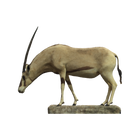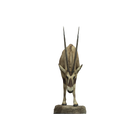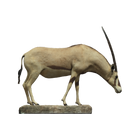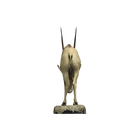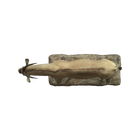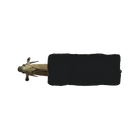| Home ≫ Research, Specimens and Materials ≫ Specimens & Database ≫ Yoshimoto Collection |
Beisa
- Click image to enlarge.
Specimen Overview
| Specimen ID |
NSMT-M 32079 Collection Database of Specimens and Materials of National Museum of Nature and Science, Japan |
|---|---|
| English Vernacular Name | Beisa |
| Scientific Name | Oryx beisa Kawada et al., 2021 |
| Specimen Type | Taxidermy specimen |
| Collection Institution | National Museum of Nature and Science, Japan |
Size of Bounding Box
| Length of front and back | 1730 mm |
|---|---|
| Width | 542 mm |
| Height | 1460 mm |
* The size of the bounding box circumscribed to the 3D model is measured, and a hyphen-only value (-) indicates unmeasured.
3D Model Viewer
- Texture of 3D Model
- Some 3D model textures reflect the color of the green background used in the scan.
- The texture resolution of the 3D model has been reduced to allow viewing on a wide range of devices.
Please click the following link to view the 3D model in its original resolution. Sketchfab
- Camera Move
- For smartphones/tablets/touch panels, one-finger drag to rotate, two-finger drag to move horizontally and vertically, pinch out to zoom in, and pinch in to zoom out.
- For a PC with a mouse, left button drag to rotate, Shift key + left button drag to move horizontally and vertically, and spin the mouse wheel/Ctrl key + left button drag to zoom in and out.
- Double-tap/double-click anywhere on the 3D model to set the center of camera rotation at that location. Double-tap/double-click on the background to reset the center of camera rotation to the center of the viewer window.
- Lighting Move
- For smartphones/tablets/touch panels, three-finger drag to rotate.
- For a PC with a mouse, Alt key + left button drag to rotate.
- Annotations
- Click/tap the number on the 3D model to display the annotation.
See also Sketchfab Help Center Link
Names of Taxa
| Order | Artiodactyla Kawada et al., 2021 |
|---|---|
| Family | Bovidae Kawada et al., 2021 |
| Genus | Oryx Kawada et al., 2021 |
Distribution
|
Location data (mainly sampled or observed locations of organisms) on GBIF (Global Biodiversity Information Facility) GBIF Web site |
|---|
IUCN (International Union for Conservation of Nature)
Redlist Category IUCN Web site
| Scientific Name on IUCN Redlist | Oryx beisa IUCN |
|---|---|
| English Vernacular Name on IUCN Redlist | Beisa Oryx IUCN |
| Redlist Category |
Endangered (EN) IUCN
|
| Population Trend | Decreasing IUCN |
| Assessment Date | 2018-02-12 IUCN |
| Published Year | 2018 IUCN |
Specimen Details
| Verbatim Specimen ID | WTY_079 |
|---|---|
| Collection Date | 1974-07 |
| Scientific Name | Oryx beisa Kawada et al., 2021 |
| English Vernacular Name | Beisa |
| Collection Country | ETHIOPIA |
| Collection Locality | Danakil, Chercher Mountains, ETHIOPIA |
| Collection Name | Yoshimoto Collection |
|
Specimen location information (locations of traveling exhibitions) |
|
Species Information
Information on ASM (American Society of Mammalogists) Mammal Diversity Database MDD Web site
| Scientific Name on MDD | Oryx beisa MDD |
|---|---|
| English Vernacular Name on MDD | Beisa Oryx MDD |
| Synonym(s) of English Vernacular Name on MDD | East African Oryx, Beisa, Galla Oryx, Fringe-eared Oryx MDD |
| Locality of Type Specimen on MDD | Red Sea coast west of Massawa, Eritrea. MDD |
Information on Mammal Species of the World, 3rd edition MSW3 Web site
| Scientific Name on MSW3 | Oryx beisa MSW3 |
|---|---|
| Locality of Type Specimen on MDW3 | Eritrea, "in den Niederungen der Küstenlandschaft bei Massaua" (Red Sea coast west of Massawa). MSW3 |
3D Model Information
References
- Kawada et al., 2021 Kawada S., Iwasa M., Fukui D., Shintaku Y., Amano M., Shimoinaba, S., Taru. S., Anezaki, T., Suzuki, S., Oshida T., and Yokohata Y. 2021. The List of Standard Japanese Names of World Mammals. The Mammal Society of Japan, https://www.mammalogy.jp/list/index.html (accessed 2021-12-28).
- S-Net National Museum of Nature and Science, Japan. 2024. Science Museum Net Record 4713912. Science Museum Net, http://science-net.kahaku.go.jp/specimen/4713912 (accessed 2024-03-24).
- GBIF
- IUCN IUCN SSC Antelope Specialist Group 2018. Oryx beisa. The IUCN Red List of Threatened Species 2018: e.T15571A50191877. https://dx.doi.org/10.2305/IUCN.UK.2018-2.RLTS.T15571A50191877.en (accessed 2024-04-15).
- MDD Mammal Diversity Database. 2022. Mammal Diversity Database (Version 1.8) [Data set]. Zenodo, https://doi.org/10.5281/zenodo.4139818 (accessed 2022-02-28).
- MSW3 Wilson, D. E. & Reeder, D. M. (editors). 2005. Mammal Species of the World. A Taxonomic and Geographic Reference (3rd ed), Johns Hopkins University Press, 2,142 pp.
Overview of Each Dataset
- Kawada et al., 2021 The List of Standard Japanese Names of World Mammals (Kawada et al., 2021) is a list of "standard Japanese names" maintained by The Mammal Society of Japan, which includes Japanese names, scientific names, and notations in other species name lists.
- S-Net S-Net (Science Museum Net) is a database that collects information on natural history specimens held by natural history museums in Japan.
- GBIF GBIF (the Global Biodiversity Information Facility) is an international network and data infrastructure funded by the world's governments and aimed at providing anyone, anywhere, open access to data about all types of life on Earth, primarily through a web database.
- IUCN IUCN (International Union for Conservation of Nature) is an international conservation network that publishes the Red List, a list of endangered wildlife species, and a database on them.
- MDD MDD (Mammal Diversity Database) is a species list compiled by the American Society of Mammalogists that provides taxonomic and biodiversity information on mammals. The following MSW3 and other information has been revised.
- MSW3 MSW3 (Mammal Species of the World, 3rd edition) is a database of mammalian taxa used as a reference for taxonomic research. It is also referenced by Kawada et al. (2021) and MDD above.

